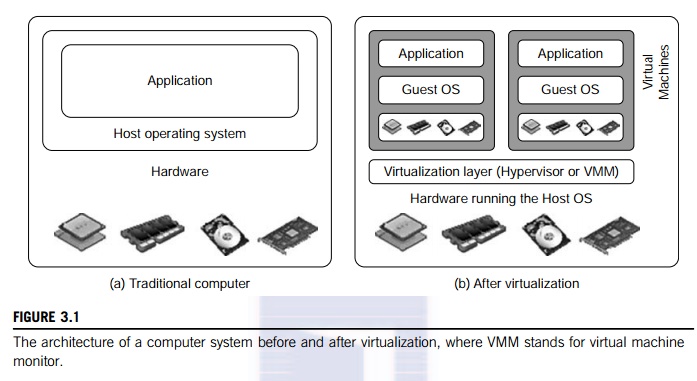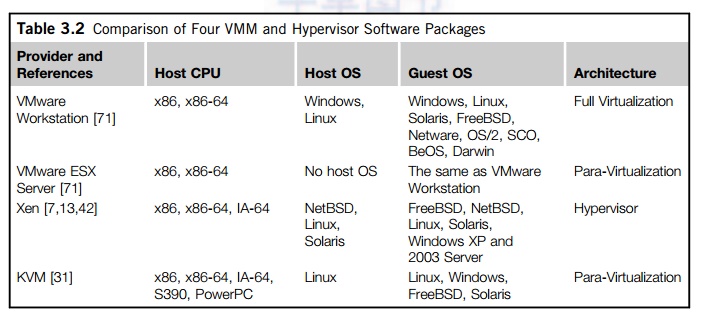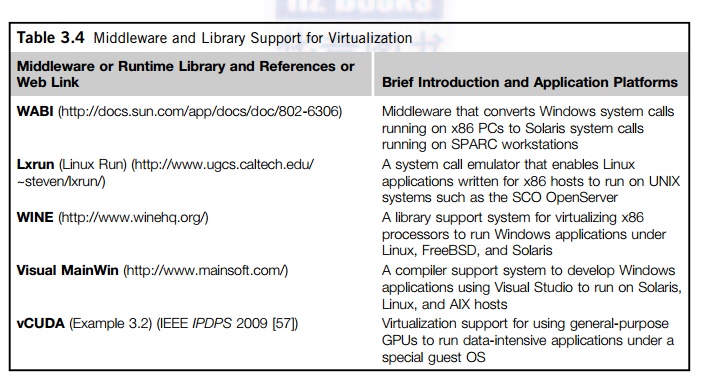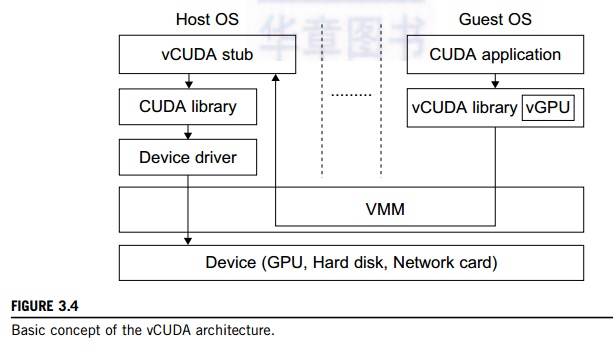Chapter: Distributed and Cloud Computing: From Parallel Processing to the Internet of Things : Virtual Machines and Virtualization of Clusters and Data Centers
Implementation Levels of Virtualization
IMPLEMENTATION LEVELS OF VIRTUALIZATION
Virtualization is a computer
architecture technology by which multiple virtual machines (VMs) are multiplexed in the same hardware
machine. The idea of VMs can be dated back to the 1960s [53]. The purpose of a
VM is to enhance resource sharing by many users and improve computer performance
in terms of resource utilization and application flexibility. Hardware
resources (CPU, memory, I/O devices, etc.) or software resources (operating
system and software libraries) can be virtualized in various functional layers.
This virtualization technology has been revitalized as the demand for
distributed and cloud computing increased sharply in recent years.
The idea
is to separate the hardware from the software to yield better system
efficiency. For example, computer users gained access to much enlarged memory space
when the concept of virtual memory was introduced. Similarly, virtualization
techniques can be applied to enhance the use of compute engines, networks, and storage. In this
chapter we will discuss VMs and their applications for building distributed systems.
According to a 2009 Gartner Report, virtualization was the top strategic
technology poised to change the computer industry. With sufficient storage, any
computer platform can be installed in another host computer, even if they use
processors with different instruction sets and run with distinct operating
systems on the same hardware.
1. Levels of Virtualization
Implementation
A traditional computer runs
with a host operating system specially tailored for its hardware architecture,
as shown in Figure 3.1(a). After virtualization, different user applications
managed by their own operating systems (guest OS) can run on the same hardware,
independent of the host OS. This is often done by adding additional software,
called a virtualization
layer as shown
in Figure 3.1(b). This virtualization layer is known as hypervisor or virtual machine monitor (VMM) [54]. The VMs are
shown in the upper boxes, where applications run with their own guest OS over
the virtualized CPU, memory, and I/O resources.
The main function of the software layer for
virtualization is to virtualize the physical hardware of a host machine into
virtual resources to be used by the VMs, exclusively. This can be implemented
at various operational levels, as we will discuss shortly. The virtualization
software creates the abstraction of VMs by interposing a virtualization layer
at various levels of a computer system. Common virtualization layers include
the instruction set architecture
(ISA) level,
hardware level, operating system level, library support level, and application
level (see Figure 3.2).


1.1
Instruction Set Architecture Level
At the ISA level,
virtualization is performed by emulating a given ISA by the ISA of the host
machine. For example, MIPS binary code can run on an x86-based host machine
with the help of ISA emulation. With this approach, it is possible to run a
large amount of legacy binary code writ-ten for various processors on any given
new hardware host machine. Instruction set emulation leads to virtual ISAs
created on any hardware machine.
The
basic emulation method is through code interpretation. An interpreter program
interprets the source instructions to target instructions one by one. One
source instruction may require tens or hundreds of native target instructions
to perform its function. Obviously, this process is relatively slow. For better
performance, dynamic
binary translation is desired. This approach translates basic blocks of dynamic
source instructions to target instructions. The basic blocks can also be
extended to program traces or super blocks to increase translation efficiency.
Instruction set emulation requires binary translation and optimization. A virtual instruction set architecture (V-ISA) thus requires adding a
processor-specific software translation layer to the compiler.
1.2
Hardware Abstraction Level
Hardware-level virtualization is performed
right on top of the bare hardware. On the one hand, this approach generates a
virtual hardware environment for a VM. On the other hand, the process manages
the underlying hardware through virtualization. The idea is to virtualize a
computer’s resources, such as its processors, memory, and I/O devices. The
intention is to upgrade the hardware utilization rate by multiple users
concurrently. The idea was implemented in the IBM VM/370 in the 1960s. More
recently, the Xen hypervisor has been applied to virtualize x86-based machines
to run Linux or other guest OS applications. We will discuss hardware
virtualization approaches in more detail in Section 3.3.
1.3
Operating System Level
This refers to an abstraction
layer between traditional OS and user applications. OS-level virtualiza-tion
creates isolated containers on a single physical server
and the OS instances to utilize the hard-ware and software in data centers. The
containers behave like real servers. OS-level virtualization is commonly used
in creating virtual hosting environments to allocate hardware resources among a
large number of mutually distrusting users. It is also used, to a lesser
extent, in consolidating server hardware by moving services on separate hosts
into containers or VMs on one server. OS-level virtualization is depicted in
Section 3.1.3.
1.4
Library Support Level
Most applications use APIs
exported by user-level libraries rather than using lengthy system calls by the
OS. Since most systems provide well-documented APIs, such an interface becomes
another candidate for virtualization. Virtualization with library interfaces is
possible by controlling the communication link between applications and the
rest of a system through API hooks. The software tool WINE has implemented this
approach to support Windows applications on top of UNIX hosts. Another example
is the vCUDA which allows applications executing within VMs to leverage GPU
hardware acceleration. This approach is detailed in Section 3.1.4.
1.5 User-Application Level
Virtualization at the
application level virtualizes an application as a VM. On a traditional OS, an
application often runs as a process. Therefore, application-level virtualization is also known as process-level virtualization. The most popular approach
is to deploy high
level language (HLL)
VMs. In this scenario, the
virtualization layer sits as an application program on top of the operating
system, and the layer exports an abstraction of a VM that can run programs
written and compiled to a particular abstract machine definition. Any program
written in the HLL and compiled for this VM will be able to run on it. The
Microsoft .NET CLR and Java
Virtual Machine (JVM) are two good examples of this class of VM.
Other forms of application-level virtualization
are known as application isolation, application sandboxing, or
application streaming. The
process involves wrapping the application in a layer that is isolated from the host OS and other applications. The result is
an application that is much easier to distribute and remove from user
workstations. An example is the LANDesk application virtuali-zation platform
which deploys software applications as self-contained, executable files in an
isolated environment without requiring installation, system modifications, or
elevated security privileges.
1.6
Relative Merits of Different Approaches
Table 3.1 compares the
relative merits of implementing virtualization at various levels. The column
headings correspond to four technical merits. “Higher Performance” and “Application Flexibility” are self-explanatory. “Implementation Complexity” implies the cost to implement that particular
vir-tualization level. “Application Isolation” refers to the effort required to isolate
resources committed to different VMs. Each row corresponds to a particular
level of virtualization.
The
number of X’s in the table cells reflects
the advantage points of each implementation level. Five X’s implies the best case and one X implies the
worst case. Overall, hardware and OS support will yield the highest
performance. However, the hardware and application levels are also the most
expensive to implement. User isolation is the most difficult to achieve. ISA
implementation offers the best application flexibility.
2. VMM Design Requirements and
Providers
As mentioned earlier, hardware-level
virtualization inserts a layer between real hardware and tradi-tional operating
systems. This layer is commonly called the Virtual Machine Monitor (VMM) and it manages the hardware
resources of a computing system. Each time programs access the hardware the VMM
captures the process. In this sense, the VMM acts as a traditional OS. One
hardware compo-nent, such as the CPU, can be virtualized as several virtual
copies. Therefore, several traditional oper-ating systems which are the same or
different can sit on the same set of hardware simultaneously.

There
are three requirements for a VMM. First, a VMM should provide an environment
for pro-grams which is essentially identical to the original machine. Second,
programs run in this environment should show, at worst, only minor decreases in
speed. Third, a VMM should be in complete control of the system resources. Any
program run under a VMM should exhibit a function identical to that which it
runs on the original machine directly. Two possible exceptions in terms of
differences are permitted with this requirement: differences caused by the
availability of system resources and differences caused by timing dependencies.
The former arises when more than one VM is running on the same machine.
The
hardware resource requirements, such as memory, of each VM are reduced, but the
sum of them is greater than that of the real machine installed. The latter
qualification is required because of the intervening level of software and the
effect of any other VMs concurrently existing on the same hardware. Obviously,
these two differences pertain to performance, while the function a VMM
pro-vides stays the same as that of a real machine. However, the identical
environment requirement excludes the behavior of the usual time-sharing
operating system from being classed as a VMM.
A VMM
should demonstrate efficiency in using the VMs. Compared with a physical
machine, no one prefers a VMM if its efficiency is too low. Traditional
emulators and complete software interpreters (simulators) emulate each
instruction by means of functions or macros. Such a method provides the most
flexible solutions for VMMs. However, emulators or simulators are too slow to
be used as real machines. To guarantee the efficiency of a VMM, a statistically
dominant subset of the virtual processor’s instructions needs to be executed directly by
the real processor, with no software intervention by the VMM. Table 3.2
compares four hypervisors and VMMs that are in use today.
Complete control of these resources by a VMM
includes the following aspects: (1) The VMM is responsible for allocating
hardware resources for programs; (2) it is not possible for a program to access
any resource not explicitly allocated to it; and (3) it is possible under
certain circumstances for a VMM to regain control of resources already
allocated. Not all processors satisfy these require-ments for a VMM. A VMM is
tightly related to the architectures of processors. It is difficult to

implement a VMM for some
types of processors, such as the x86. Specific limitations include the
inability to trap on some privileged instructions. If a processor is not
designed to support virtualization primarily, it is necessary to modify the
hardware to satisfy the three requirements for a VMM. This is known as
hardware-assisted virtualization.
3. Virtualization Support at the OS
Level
With the help of VM
technology, a new computing mode known as cloud computing is emerging. Cloud
computing is transforming the computing landscape by shifting the hardware and
staffing costs of managing a computational center to third parties, just like
banks. However, cloud computing has at least two challenges. The first is the
ability to use a variable number of physical machines and VM instances
depending on the needs of a problem. For example, a task may need only a single
CPU dur-ing some phases of execution but may need hundreds of CPUs at other
times. The second challenge concerns the slow operation of instantiating new
VMs. Currently, new VMs originate either as fresh boots or as replicates of a template
VM, unaware of the current application state. Therefore, to better support
cloud computing, a large amount of research and development should be done.
3.1
Why OS-Level Virtualization?
As mentioned earlier, it is
slow to initialize a hardware-level VM because each VM creates its own image
from scratch. In a cloud computing environment, perhaps thousands of VMs need
to be initi-alized simultaneously. Besides slow operation, storing the VM
images also becomes an issue. As a matter of fact, there is considerable
repeated content among VM images. Moreover, full virtualiza-tion at the
hardware level also has the disadvantages of slow performance and low density,
and the need for para-virtualization to modify the guest OS. To reduce the
performance overhead of hardware-level virtualization, even hardware
modification is needed. OS-level virtualization provides a feasible solution
for these hardware-level virtualization issues.
Operating
system virtualization inserts a virtualization layer inside an operating system
to partition a machine’s physical resources. It
enables multiple isolated VMs within a single operating system kernel. This
kind of VM is often called a virtual
execution environment (VE), Virtual Private System (VPS), or simply container. From the user’s point of view, VEs look like real ser-vers.
This means a VE has its own set of processes, file system, user accounts,
network interfaces with IP addresses, routing tables, firewall rules, and other
personal settings. Although VEs can be customized for different people, they
share the same operating system kernel. Therefore, OS-level virtualization is
also called single-OS image virtualization. Figure 3.3 illustrates operating
system virtualization from the point of view of a machine stack.
3.2
Advantages of OS Extensions
Compared to hardware-level virtualization, the
benefits of OS extensions are twofold: (1) VMs at the operating system level
have minimal startup/shutdown costs, low resource requirements, and high
scalability; and (2) for an OS-level VM, it is possible for a VM and its host
environment to synchro-nize state changes when necessary. These benefits can be
achieved via two mechanisms of OS-level virtualization: (1) All OS-level VMs on
the same physical machine share a single operating system kernel; and (2) the
virtualization layer can be designed in a way that allows processes in VMs to
access as many resources of the host machine as possible, but never to modify
them. In cloud

computing, the first and second
benefits can be used to overcome the defects of slow initialization of VMs at
the hardware level, and being unaware of the current application state,
respectively.
3.3
Disadvantages of OS Extensions
The main disadvantage of OS
extensions is that all the VMs at operating system level on a single container
must have the same kind of guest operating system. That is, although different
OS-level VMs may have different operating system distributions, they must
pertain to the same operating system family. For example, a Windows
distribution such as Windows XP cannot run on a Linux-based container. However,
users of cloud computing have various preferences. Some prefer Windows and
others prefer Linux or other operating systems. Therefore, there is a challenge
for OS-level virtualization in such cases.
Figure 3.3 illustrates the
concept of OS-level virtualization. The virtualization layer is inserted inside
the OS to partition the hardware resources for multiple VMs to run their
applications in multiple virtual environments. To implement OS-level
virtualization, isolated execution environ-ments (VMs) should be created based
on a single OS kernel. Furthermore, the access requests from a VM need to be
redirected to the VM’s local resource partition on
the physical machine. For example, the chroot command in a UNIX system can create several
virtual root directories within a host OS. These virtual root directories are
the root directories of all VMs created.
There
are two ways to implement virtual root directories: duplicating common
resources to each VM partition; or sharing most resources with the host
environment and only creating private resource copies on the VM on demand. The
first way incurs significant resource costs and overhead on a physical machine.
This issue neutralizes the benefits of OS-level virtualization, compared with
hardware-assisted virtualization. Therefore, OS-level virtualization is often a
second choice.
3.4
Virtualization on Linux or Windows Platforms
By far, most reported OS-level
virtualization systems are Linux-based. Virtualization support on the
Windows-based platform is still in the research stage. The Linux kernel offers
an abstraction layer to allow software processes to work with and operate on
resources without knowing the hardware details. New hardware may need a new
Linux kernel to support. Therefore, different Linux plat-forms use patched
kernels to provide special support for extended functionality.
However,
most Linux platforms are not tied to a special kernel. In such a case, a host
can run several VMs simultaneously on the same hardware. Table 3.3 summarizes
several examples of OS-level virtualization tools that have been developed in
recent years. Two OS tools (Linux vServer and OpenVZ) support Linux platforms to
run other platform-based applications through virtualiza-tion. These two
OS-level tools are illustrated in Example 3.1. The third tool, FVM, is an
attempt specifically developed for virtualization on the Windows NT platform.
Example 3.1 Virtualization Support for the
Linux Platform
OpenVZ is an OS-level tool designed to support
Linux platforms to create virtual environments for running VMs under different
guest OSes. OpenVZ is an open source container-based virtualization solution
built on Linux. To support virtualization and isolation of various subsystems,
limited resource management, and checkpointing, OpenVZ modifies the Linux
kernel. The overall picture of the OpenVZ system is illustrated in Figure 3.3.
Several VPSes can run simultaneously on a physical machine. These VPSes look
like normal
Table 3.3 Virtualization Support for Linux and Windows NT
Platforms

Linux
servers. Each VPS has its own files, users and groups, process tree, virtual
network, virtual devices, and IPC through semaphores and messages.
The resource management
subsystem of OpenVZ consists of three components: two-level disk alloca-tion, a
two-level CPU scheduler, and a resource controller. The amount of disk space a
VM can use is set by the OpenVZ server administrator. This is the first level
of disk allocation. Each VM acts as a standard Linux system. Hence, the VM
administrator is responsible for allocating disk space for each user and group.
This is the second-level disk quota. The first-level CPU scheduler of OpenVZ
decides which VM to give the time slice to, taking into account the virtual CPU
priority and limit settings.
The second-level CPU
scheduler is the same as that of Linux. OpenVZ has a set of about 20 parameters
which are carefully chosen to cover all aspects of VM operation. Therefore, the
resources that a VM can use are well controlled. OpenVZ also supports
checkpointing and live migration. The complete state of a VM can quickly be
saved to a disk file. This file can then be transferred to another physical
machine and the VM can be restored there. It only takes a few seconds to
complete the whole process. However, there is still a delay in processing
because the established network connections are also migrated.
4. Middleware Support for Virtualization
Library-level virtualization
is also known as user-level Application
Binary Interface (ABI) or API emulation. This type of virtualization can create execution
environments for running alien programs on a platform rather than creating a VM
to run the entire operating system. API call interception and remapping are the
key functions performed. This section provides an overview of several
library-level virtualization systems: namely the Windows Application Binary Interface (WABI), lxrun, WINE, Visual
MainWin, and vCUDA, which are summarized in Table 3.4.

The WABI
offers middleware to convert Windows system calls to Solaris system calls.
Lxrun is really a system call emulator that enables Linux applications written
for x86 hosts to run on UNIX systems. Similarly, Wine offers library support
for virtualizing x86 processors to run Windows appli-cations on UNIX hosts.
Visual MainWin offers a compiler support system to develop Windows
appli-cations using Visual Studio to run on some UNIX hosts. The vCUDA is
explained in Example 3.2 with a graphical illustration in Figure 3.4.
Example 3.2 The vCUDA for Virtualization of
General-Purpose GPUs
CUDA is
a programming model and library for general-purpose GPUs. It leverages the high
performance of GPUs to run compute-intensive applications on host operating
systems. However, it is difficult to run CUDA applications on hardware-level
VMs directly. vCUDA virtualizes the CUDA library and can be installed on guest
OSes. When CUDA applications run on a guest OS and issue a call to the CUDA
API, vCUDA intercepts the call and redirects it to the CUDA API running on the
host OS. Figure 3.4 shows the basic concept of the vCUDA architecture [57].
The
vCUDA employs a client-server model to implement CUDA virtualization. It
consists of three user space components: the vCUDA library, a virtual GPU in
the guest OS (which acts as a client), and the vCUDA stub in the host OS (which
acts as a server). The vCUDA library resides in the guest OS as a substitute
for the standard CUDA library. It is responsible for intercepting and
redirecting API calls from the client to the stub. Besides these tasks, vCUDA
also creates vGPUs and manages them.
The functionality of a vGPU
is threefold: It abstracts the GPU structure and gives applications a uni-form
view of the underlying hardware; when a CUDA application in the guest OS
allocates a device’s mem-ory the vGPU can return a local virtual address to the
application and notify the remote stub to allocate the real device memory, and
the vGPU is responsible for storing the CUDA API flow. The vCUDA stub receives

and
interprets remote requests and creates a corresponding execution context for
the API calls from the guest OS, then returns the results to the guest OS. The
vCUDA stub also manages actual physical resource allocation.
Related Topics